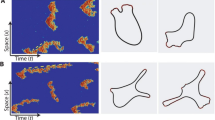Abstract
A sperm penetrates an egg by extending a long, actin-filled tube known as the acrosomal process. This simple example of biomotility is one of the most dramatic. In Thyone, a 90 μm process can extend in less than 10 s. Experiments have shown that actin monomers stored in the base of the sperm are transported to the growing tip of the acrosomal process where they add to the ends of the existing filaments.
The force that drives the elongation of the acrosomal process has not yet been identified although the most frequently discussed candidate is the actin polymerization reaction. Developing what we believe are realistic moving boundary models of diffusion limited actin fiber polymerization, we show that actin filament growth occurs too slowly to drive acrosomal elongation. We thus believe that other forces, such as osmotically driven water flow, must play an important role in causing the elongation. We conjecture that actin polymerization merely follows to give the appropriate shape to the growing structure and to stabilize the structure once water flow ceases.
Similar content being viewed by others
References
Abramowitz, M., Stegun, I. A.: Handbook of mathematical functions. Washington, D.C.: National Bureau of Standards 1964
Aebi, W., Fowler, W. E., Isenberg, G., Pollard, T. D., Smith, P. R.: Crystalline actin sheets: their structure and polymorphism. J. Cell Biol. 91, 340–351 (1981)
Bonder, E. M., Fishkind, D. J., Mooseker, M. S.: Direct measurement of critical concentrations and assembly rate constants at the two ends of an actin filament. Cell 34, 491–501 (1983)
Cannon, J. R.: The one-dimensional heat equation, Vol. 23. In: Encyclopeida of mathematics and its applications series. Addison-Wesley, Menlo Park, CA 1984
Coluccio, L. M., Tilney, L. G.: Phalloidin enhances assembly by preventing monomer dissociation. J. Cell Biol. 99, 529–535 (1984)
Crank, J.: Diffusion with rapid irreversible immobilization. Trans. Faraday Soc. 53, 1083–1091 (1957a)
Crank, J.: Two methods for the numerical solution of moving-boundary problems in diffusion and heat flow. Quart. J. Mech. Appl. Math 10 220–231 (1957b)
Dan, J. C., Hagiwara, Y.: Studies on the acrosome. IX. Course of acrosome reaction in the starfish. J. Ultrastruct. Res. 18, 562–579. (1967)
Dan, J. C., Ohori, Y., Kushida, H.: Studies on the acrosome. VII. Formation of the acrosomal process in sea urchin spermatoza. J. Ultrastruct. Res. 11, 508–524 (1964)
Hermans, J. J.: Diffusion with discontinuous boundary. J. Colloid Sci. 2, 387–398 (1947)
Hill, T. L.: Microfilament or microtubule assembly or disassembly against a force. Proc. Natl. Acad. Sci. USA 78, 5613–5617 (1981)
Hill, T. L., Kirschner, M. W.: Subunit treadmilling of microtubules or actin in the presence of cellular barriers: possible conversion of chemical free energy into mechanical work. Proc. Natl. Acad. Sci. USA 79, 490–494 (1982)
Inoué, S., Tilney, L. G.: The acrosomal reaction of Thyone sperm. I. Changes in the sperm head visualized by high resolution video microscopy. J. Cell Biol. 93, 812–819 (1982)
Kevorkian, J., Cole, J. D.: Perturbation Methods in Applied Mathematics. Springer, Berlin Heidelberg New York 1981
Markey, F., Larsson, H., Weber, K., Lindberg, U.: Nucleation of actin polymerization from profilactin opposite effects of different nuclei. Biochem. Biophys. Acta 704, 43–51 (1982)
Morse, P. M., Feshbach, H.: Methods of Theoretical Physics, Part II. McGraw-Hill, New York 1953
Murray, J. D.: Asymptotic Analysis. Springer, Berlin Heidelberg New York 1984
Oster, G. F., Perelson, A. S., Tilney, L. G.: A mechanical model for elongation of the acrosomal process in Thyone sperm. J. Math. Biol. 15, 259–265 (1982)
Pollard, T. D., Mooseker, M. S.: Direct measurement of actin polymerization rate constants by elecron microsopy of actin filaments nucleated by isolated microvillus cores. J. Cell Biol. 88, 654–659 (1981)
Tilney, L. G.: The role of actin in nonmuscle cell motility. In: Inoué, S., Stephens, R. E. (eds.) Molecules and cell movement, pp. 339–386. Raven Press, New York 1975
Tilney, L. G.: Actin, motility and membranes: In: Cone, R. A., Dowling, J. E. (eds.) Membrane transduction mechanisms, pp. 163–186. Raven Press, New York 1979
Tilney, L. G., Bonder, E. M., Coluccio, L. M., Mooseker, M. S.: Actin from Thyone sperm assembles on only one end of an actin filament: a behavior regulated by profilin. J. Cell Biol. 97, 112–124 (1983)
Tilney, L. G., Hatano, S., Ishikawa, H., Mooseker, M. S.: The polymerization of actin: its role in the generation of the acrosomal process of certain echinoderm sperm. J. Cell Biol. 59, 109–126 (1973)
Tilney, L. G., Kallenbach, N.: Polymerization of actin. VI. The polarity of the actin filaments in the acrosomal process and how it might be determined. J. Cell Biol. 81, 608–623 (1979)
Tilney, L. G., Inoué, S.: Acrosomal reaction of Thyone sperm. II. The kinetics and possible mechanism of acrosomal process elongation. J. Cell Biol. 93, 820–827 (1982)
Tobacman, L. S., Korn E. D.: The regulation of actin polymerization and the inhibition of monomeric actin ATPase activity by Acanthamoeba profilin. J. Biol. Chem. 257, 4166–4170 (1982)
Tseng, P. C.-H., Pollard, T. D.: Mechanism of a tin of Acanthamoeba profilin: demonstration of actin species specificity regulation by micromolar concentrations of MgCl2. J. Cell Biol. 94, 213–218 (1982)
Wegner, A.: Head to tail polymerization of actin. J. Mol. Biol. 108, 139–150 (1976)
Author information
Authors and Affiliations
Additional information
Work partially supported by the United States Department of Energy
Rights and permissions
About this article
Cite this article
Perelson, A.S., Coutsias, E.A. A moving boundary model of acrosomal elongation. J. Math. Biology 23, 361–379 (1986). https://doi.org/10.1007/BF00275254
Received:
Revised:
Issue Date:
DOI: https://doi.org/10.1007/BF00275254




